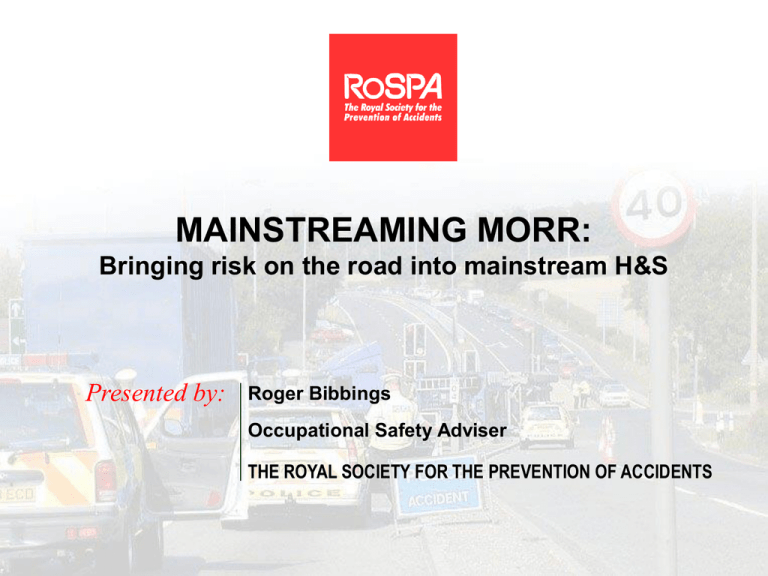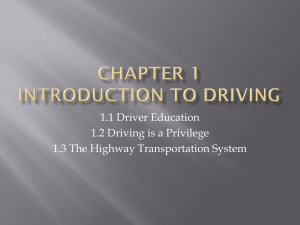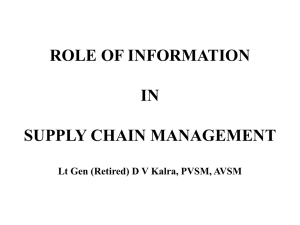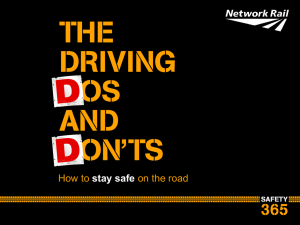A2 Roger Bibbings
advertisement

MAINSTREAMING MORR: Bringing risk on the road into mainstream H&S Presented by: Roger Bibbings Occupational Safety Adviser THE ROYAL SOCIETY FOR THE PREVENTION OF ACCIDENTS RoSPA’s mission “RoSPA’s mission is to enhance the quality of life by exercising a powerful influence for accident prevention” ‘Key issues’ to date: managing occupational road risk (MORR) accident investigation (Acc Inv) director action on safety and health (DASH) Road casualties G.B. 1981/85 average 1994/98 average 2003 Percentage reduction KILLED SERIOUSLY INJURED 5,598 3,578 3,508 37 74,534 44,078 33,707 55 (approx 40 per cent increase in traffic volume) Occupational road accidents: key points 800 – 1000 deaths per annum (‘at work’ drivers/passengers/ pedestrians, other road users) compared with 450 RIDDOR UK’s biggest occupational safety issue Excluded from mainstream H&S management/enforcement Action needed on company cars and vans Prevention focused on management not just drivers! MORR can contribute to national RS targets (40% reduction KSI by 2010) Who is at risk? Commercial vehicle drivers Sales staff Service engineers Delivery workers Social workers Emergency services Local authority staff Bus and coach drivers & passengers Voluntary workers Motorcycle couriers Pizza delivery riders Police Paramedics Government officials Teachers Vehicle recovery staff Health workers At-work pedestrians Anyone on the road as part of their job!!!! MORR initiatives 1996/7: RoSPA seminars (Esso/EEF) 1998: RoSPA Guidance/ Stoke Court ‘Declaration’ 1999: input to ‘Tomorrow’s Roads’ 2000/2001: WRRSTG (Dykes report) (www.hse.gov.uk/road/content/traffic1.pdf) 2002: ORSA 2003: New HSE/DfT guidance/RoSPA guidance 2nd edition 2004: New ORSA website/work programme Causes of road crashes? IMMEDIATE: inappropriate speed inattention falling asleep travelling too close drink/drugs adverse weather vehicle defects highway conditions UNDERLYING: pressure/attitudes distractions/fatigue inadequate sleep congestion stress poor journey planning poor maintenance poor routeing Employer impact on crash risk Exacerbate Too far Too fast (incentives to speed etc) Unsafe routes Unsafe conditions Unsafe vehicles Stressed, tired, untrained drivers Mobiles Poor H&S culture Ameliorate Reducing exposure Clear policy on speed Journey planning Safer vehicles Driver assessment and training Action to combat fatigue ‘No mobile while mobile’ Clear MORR policies Leadership by example The case for action Ethics, CSR etc Legal compliance The ‘business case’ Company values.. ‘Nothing we do is so important that it justifies injuring our employees or members of the public’ Major Utility CEO The legal context Two sets of law..... HSW Act (‘safe system of work’, MHSW Regs (risk assessment, management system) (enforced by HSE/LAs but not on road) plus Road Traffic Acts, Highway Code, C&U Regs etc (enforced by police, concerned mainly with driver behaviour) New HSE/DfT guidance ‘Driving at Work’ - Sept ‘03 (Accessible at http://www.hse.gov.uk/pubns/indg382.pdf) • Explains how H&S law applies on the road • Suggests approaches to risk assessment • Suggests control measures/performance review • Signposts further information • Highlights the ‘business case’ From HSE caveat … “…. HSC’s enforcement policy statement recognises the need to prioritise investigation and enforcement action. Current priorities, as set out in HSC’s strategic plan, do not include work-related road safety ….” Threats to the business Accident costs Lost business Lost staff time Higher fleet premia Loss of morale Threat to corporate reputation Notices and/or prosecutions Common law claims Corporate manslaughter? What are businesses doing? MOST NOTHING AT ALL !!!! but some…. driver handbooks ‘how’s my driving?’ licence checks negative penalties/positive incentives crash data analysis driver assessment DRIVER TRAINING… Yes, OK BUT…. managing occupational road risk is not driver training…. Managing occupational road risk means… developing a risk management approach, i.e. putting in place the policies, people, procedures to ‘work the problem’ !! Using the HSG65 framework A 1. define policy objectives U 2. organise and train D 3. plan and implement I 4. measure performance T 5. review and feedback Using risk assessment… To help managers and/or drivers understand:- 1. ‘How, when, who, how bad etc?’ 2. Whether existing controls adequate or more needed? 3. Which risks to tackle first? Generic risk assessment Review risk enhancing features of: journey tasks vehicles drivers Some key risk factors Journey task (speed? fatigue? routeing? weather, night/day?) Vehicle (fit for purpose? properly maintained? Additional features?) Driver ( age, experience? fitness/eyesight/stress? crashes/points? attitudes/competence?) Preferred approaches to risk control 1. eliminate 2. reduce 3. isolate 4. control 5. adapt meeting without moving change/mix mode reduce journeys/mileage reduce hours/distances optimise schedules plan ‘safer’ routes avoid adverse conditions specify ‘safer’ vehicles ensure maintenance assess driver fitness reduce distractions alcohol/drugs policies assess driver competence prioritised driver training Supported by… Training for line-managers Information, guidance and supervision Performance targets/timescales Emergency procedures/personal safety Monitoring (from licence/vehicle checks to ‘black boxes’ to ‘how’s my driving?’) Crash/near-hit reporting/investigation Awards/incentives etc. In-house policies needed for… Speed (all staff to comply with limits) Combating fatigue (preparation for driving, mileage limits, caff/napping etc) Night/adverse weather driving (avoidance) Vehicle specs/maintenance (fit for person/purpose etc) Driver fitness (stress, ill health, eye sight..) Drugs/alcohol (including non- prescription medicines) Mobile phones etc etc (‘no mobile when mobile!’) Driver competence (higher grades for higher risk drivers?) Data, data, data… Fleet profile Accidents/incidents Vehicles (by type) Reference Drivers (status, age, Claim? (claim no) gender, experience, Incident date/time enforcement, training etc) Vehicle type/reg no Journeys/miles Driver (name/gender/age) Accidents/incidents Location Severities Collision type Causes Blameworthy? Costs (insured/uninsured) Costs Three key steps 1) Where are we now? • Vehicles, drivers, miles, crashes, causes, costs? • Management system (policy, organisation, planning, monitoring, review)? 2) Set up a joint team (H&S, HR, Fleet, SRs etc) 3) Develop an ‘action plan’ to: • develop ‘management system’, • assess risks, prioritise interventions • set standards, targets, timescales etc • implement • monitor, review and feed back lessons learned Team working and partnership Professionals Drivers and safety reps Insurers/brokers (e.g. crash data feedback) Vehicle providers etc Local road safety organisations Sector peers MORR service providers… RoSPA and MORR: where next?: • Lobbying HSC/DfT to establish Dykes MkII ORSA, membership, research group etc • European liaison/international comparisons • Focusing on ‘best practice’ via ORSA • Lobbying to make MORR a higher priority • ‘Meeting without moving’ • More MORR seminars/public speaking etc • Progress review? Government must … • • • • • • • • • • Accept WRRS is a major issue Increase HSE resources for WRRS Facilitate performance benchmarking Link WRRS and site transport safety agendas Enforce where necessary Respond to worker/public complaints Ensure liaison in crash investigations Take high profile prosecutions Lead the WRRS research agenda Take a lead as exemplar employer Some useful websites • www.rospa.com (go ‘occupational safety’) • www.orsa.org.uk • www.morr.org.uk • www.hse.gov.uk/roadsafety • www.airso.org.uk • www.roadsafe.com • www.pacts.org.uk • www.brake.org.uk • www.larsoa.org • www.rospa.com/drivertraining Challenge everyone to …



